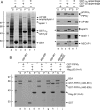Clathrin regulates the association of PIPKIgamma661 with the AP-2 adaptor beta2 appendage
- PMID: 19287005
- PMCID: PMC2679492
- DOI: 10.1074/jbc.M901017200
Clathrin regulates the association of PIPKIgamma661 with the AP-2 adaptor beta2 appendage
Abstract
The AP-2 clathrin adaptor differs fundamentally from the related AP-1, AP-3, and AP-4 sorting complexes because membrane deposition does not depend directly on an Arf family GTPase. Instead phosphatidylinositol 4,5-bisphosphate (PtdIns(4,5)P(2)) appears to act as the principal compartmental cue for AP-2 placement at the plasma membrane as well as for the docking of numerous other important clathrin coat components at the nascent bud site. This PtdIns(4,5)P(2) dependence makes type I phosphatidylinositol 4-phosphate 5-kinases (PIPKIs) lynchpin enzymes in the assembly of clathrin-coated structures at the cell surface. PIPKIgamma is the chief 5-kinase at nerve terminals, and here we show that the 26-amino acid, alternatively spliced C terminus of PIPKIgamma661 is an intrinsically unstructured polypeptide that binds directly to the sandwich subdomain of the AP-2 beta2 subunit appendage. An aromatic side chain-based, extended interaction motif that also includes the two bulky C-terminal residues of the short PIPKIgamma635 variant is necessary for beta2 appendage engagement. The clathrin heavy chain accesses the same contact surface on the AP-2 beta2 appendage, but because of additional clathrin binding sites located within the unstructured hinge segment of the beta2 subunit, clathrin binds the beta2 chain with a higher apparent affinity than PIPKIgamma661. A clathrin-regulated interaction with AP-2 could allow PIPKIgamma661 to be strategically positioned for regional PtdIns(4,5)P(2) generation during clathrin-coated vesicle assembly at the synapse.
Figures










Similar articles
-
Molecular basis for association of PIPKI gamma-p90 with clathrin adaptor AP-2.J Biol Chem. 2010 Jan 22;285(4):2734-49. doi: 10.1074/jbc.M109.074906. Epub 2009 Nov 10. J Biol Chem. 2010. PMID: 19903820 Free PMC article.
-
A phosphotyrosine switch for cargo sequestration at clathrin-coated buds.J Biol Chem. 2014 Jun 20;289(25):17497-514. doi: 10.1074/jbc.M114.556589. Epub 2014 May 5. J Biol Chem. 2014. PMID: 24798335 Free PMC article.
-
The AP-2 adaptor beta2 appendage scaffolds alternate cargo endocytosis.Mol Biol Cell. 2008 Dec;19(12):5309-26. doi: 10.1091/mbc.e08-07-0712. Epub 2008 Oct 8. Mol Biol Cell. 2008. PMID: 18843039 Free PMC article.
-
Sorting it out: AP-2 and alternate clathrin adaptors in endocytic cargo selection.J Cell Biol. 2003 Oct 27;163(2):203-8. doi: 10.1083/jcb.200309175. J Cell Biol. 2003. PMID: 14581447 Free PMC article. Review.
-
Phosphoinositide regulation of clathrin-mediated endocytosis.Biochem Soc Trans. 2005 Dec;33(Pt 6):1285-9. doi: 10.1042/BST0331285. Biochem Soc Trans. 2005. PMID: 16246100 Review.
Cited by
-
Phosphoinositide signaling regulates the exocyst complex and polarized integrin trafficking in directionally migrating cells.Dev Cell. 2012 Jan 17;22(1):116-30. doi: 10.1016/j.devcel.2011.10.030. Dev Cell. 2012. PMID: 22264730 Free PMC article.
-
Role of phosphoinositides at the neuronal synapse.Subcell Biochem. 2012;59:131-75. doi: 10.1007/978-94-007-3015-1_5. Subcell Biochem. 2012. PMID: 22374090 Free PMC article. Review.
-
EGFR-induced phosphorylation of type Iγ phosphatidylinositol phosphate kinase promotes pancreatic cancer progression.Oncotarget. 2017 Jun 27;8(26):42621-42637. doi: 10.18632/oncotarget.16730. Oncotarget. 2017. PMID: 28388589 Free PMC article.
-
The inositol 5-phosphatase SHIP2 regulates endocytic clathrin-coated pit dynamics.J Cell Biol. 2010 Aug 9;190(3):307-15. doi: 10.1083/jcb.201005018. Epub 2010 Aug 2. J Cell Biol. 2010. PMID: 20679431 Free PMC article.
-
Phosphatidic acid and neurotransmission.Adv Biol Regul. 2017 Jan;63:15-21. doi: 10.1016/j.jbior.2016.09.004. Epub 2016 Sep 20. Adv Biol Regul. 2017. PMID: 27671966 Free PMC article. Review.
References
-
- Di Paolo, G., and De Camilli, P. (2006) Nature 443 651-657 - PubMed
-
- Maldonado-Baez, L., and Wendland, B. (2006) Trends Cell Biol. 16 505-513 - PubMed
-
- Schmid, E. M., and McMahon, H. T. (2007) Nature 448 883-888 - PubMed
-
- Ungewickell, E. J., and Hinrichsen, L. (2007) Curr. Opin. Cell Biol. 19 417-425 - PubMed
Publication types
MeSH terms
Substances
Grants and funding
LinkOut - more resources
Full Text Sources
Molecular Biology Databases
Research Materials

